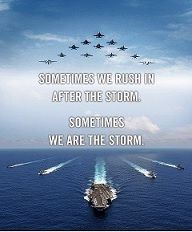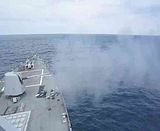As most of you know by now, I spent the bulk of my career (20 of 25 years) in the field of Surface Warfare. Three years of purgatory in an aircraft carrier, and the rest where people like me belong; in frigates, a cruiser, and an afloat staff. I also taught twice at Surface Warfare Officers School Command, so to say I am steeped in the traditions of those who went before me would be an understatement.
What I propose for this thread is simply a place to post those videos or perhaps written anecdotes about destroyers and cruisers and the men (and now women) who make them live and breathe. This first one is sort of fun because it demonstrates some pretty reliable firepower that often gets lost in all of "Oooh-ing" and "Awww-ing" over this missile or that. This the Mark 45 Mod 4 5"/62 caliber main gun that is found in the later flights of the Arleigh Burke-class destroyers. For the uninitiated, that's 21 rounds in 1:15. Each round is 70 pounds of "boom" which, with the 62 caliber gun tube, can be felt somewhere between 13 and 20 miles away. The really nice thing about this gun system is that it is capable in three of four surface warfare missions; naval gunfire support of troops on the beach, anti-air defense, and anti-surface unit defense. Imagine the ship in the NGFS mission getting a call for fire, troops in the open, fire for effect. With one spotting round, that gunfire control system will lock in there and just keep dropping VT rounds that are exploding 20 or so feet overhead, turning everything underneath into a pink mist. It's things like this that make my . . . well, let's just say I get a little excited. :)
What I propose for this thread is simply a place to post those videos or perhaps written anecdotes about destroyers and cruisers and the men (and now women) who make them live and breathe. This first one is sort of fun because it demonstrates some pretty reliable firepower that often gets lost in all of "Oooh-ing" and "Awww-ing" over this missile or that. This the Mark 45 Mod 4 5"/62 caliber main gun that is found in the later flights of the Arleigh Burke-class destroyers. For the uninitiated, that's 21 rounds in 1:15. Each round is 70 pounds of "boom" which, with the 62 caliber gun tube, can be felt somewhere between 13 and 20 miles away. The really nice thing about this gun system is that it is capable in three of four surface warfare missions; naval gunfire support of troops on the beach, anti-air defense, and anti-surface unit defense. Imagine the ship in the NGFS mission getting a call for fire, troops in the open, fire for effect. With one spotting round, that gunfire control system will lock in there and just keep dropping VT rounds that are exploding 20 or so feet overhead, turning everything underneath into a pink mist. It's things like this that make my . . . well, let's just say I get a little excited. :)













 are manning the windlass brake. Whoever posted the video does a pretty good job of pointing out the various shots of chain paying out and so forth. Even someone who's never been to sea can figure out that great badness is occurring here. They are fortunate that no one was hurt or worse.
are manning the windlass brake. Whoever posted the video does a pretty good job of pointing out the various shots of chain paying out and so forth. Even someone who's never been to sea can figure out that great badness is occurring here. They are fortunate that no one was hurt or worse. 
Comment